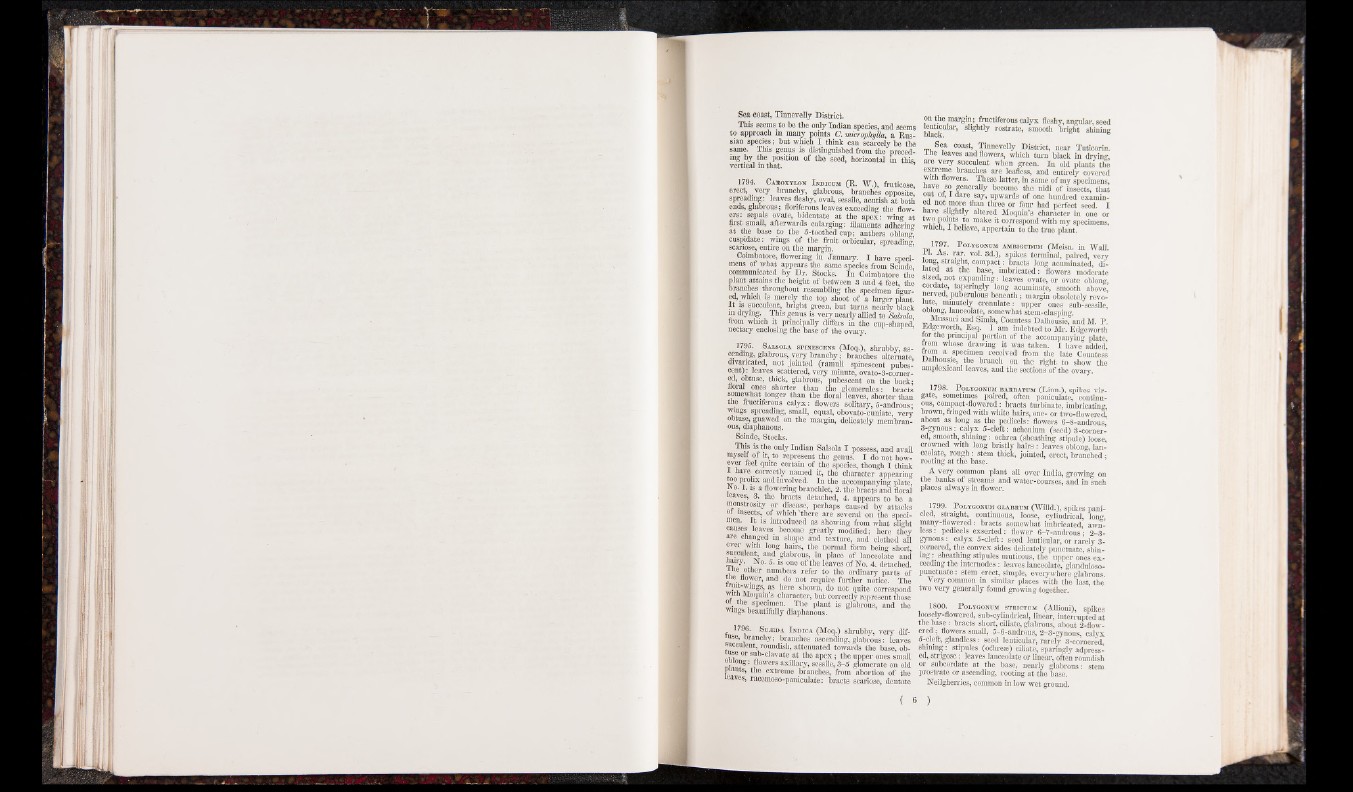
Sea coast, Tinnevelly District.
This seems to be the only Indian species, and seems
to approach in many points C. microphylla, a Russian
species; but which I think can scarcely be the
same. This genus is distinguished from the preceding
by the position of the seed, horizontal in this,
vertical in that.
1794. Caboxylon Indicum (R. W.), fruticose,
erect, very branchy, glabrous, branches opposite,
spreading: leaves fleshy, oval, sessile, acutish at both
ends, glabrous; floriferous leaves exceeding the flowers:
sepals ovate, bidentate at the apex: wing at
first small, afterwards enlarging: filaments adhering
at the base to the 5-toothed cup; anthers oblong
cuspidate: wings of the fruit orbicular, spreading
scariose, entire on the margin.
Coimbatore, flowering in January. I have specimens
of what appears the same species from Scmde,
communicated by Dr. Stocks. In Coimbatore the
plant attains the height of between 3 and 4 feet, the
branches throughout resembling the specimen figured,
which is merely the top shoot of a larger plant.
I t is succulent, bright green, but turns nearly black
m drying. This genus is very nearly allied to Salsola,
from which it principally differs in the cup-shaped,
nectary enclosing the base of the ovary.
1795. Salsola spinescens (Moq.), shrubby, ascending,
glabrous, .very branchy; branches alternate,
divaricated, not jointed (ramuli spinescent pubescent)
: leaves scattered, very minute, ovato-3-corner-
ed, obtuse, thick, glabrous, pubescent on the back;
floral ones shorter than the glomerules: bracts
somewhat longer than the floral leaves, shorter than
the fructiferous calyx: flowers solitary, 5-androus;
wings spreading, small, equal, obovato-cuniate, very
obtuse, gnawed on the margin, delicately membranous,
diaphanous.
Scinde, Stocks.
This is the only Indian Salsola I possess, and avail
myself of it, to represent the genus. I do not however
feel quite certain of the species, though I f.iiinir
i have correctly named it, the character appearing
too prolix and involved. In the accompanying plate,
JNo. 1. is a flowering branchlet, 2. the bracts and floral
leaves, 3. the bracts detached, 4. appeal’s to be a
monstrosity or disease, perhaps caused by attacks
oi insects, of which'there are several on the specimen.
I t is introduced as showing from what slight
causes leaves become greatly modified; here they
are changed in shape and texture, and clothed all
over with long hairs, the normal form being short,
succulent, and glabrous, in place of lanceolate and
hairy. -No. 5. is one of the leaves of ISTo. 4. detached,
lh e other numbers refer to the ordinary parts of
the flower, and do not require further notice. The
I M D 0 here sli0wn> do not quite correspond
witn Moqiun s character, but correctly represent those
or the specimen. The plant is glabrous, and the
wings beautifully diaphanous.
1796. SuiEDA Indica (Moq.) shrubby, very diffuse,
branchy; branches ascending, glabrous: leaves
succulent, roundish, attenuated towards the base, ob-
use or sub-clavate at the ap ex ; the upper ones small
oDiong: flowers axillary, sessile, 3-5 glomerate on old
Plants, the extreme branches, from abortion of the
ves, racemoso-paniculate: bracts scariose, dentate
on the margin ; fructiferous calyx fleshy, angular, seed
black ^ sliglltJy rostrate> smooth bright shining
Sea coast, Tinnevelly District, near Tuticorin.
lh e leaves and flowers, which turn black in drying,
are very succulent when green. In old plants the
extreme branches are leafless, and entirely covered
with flowers. These latter, in some of my specimens,
have so generally become the nidi of insects, that
out of, I dare say, upwards of one hundred examined
not more than three or four had perfect seed. I
have slightly altered Moquin’s character in one or
two points to make it correspond with my specimens,
which, I believe, appertain to the true plant.
1797. Polygonum ambigudum (Meisn. in Wall.
1:1. As. rar. vol. 3d.), spikes terminal, paired, very
long, straight, compact: bracts long acuminated, dilated
at the base, imbricated :■ flowers moderate
sized, not expanding: leaves ovate, or ovate oblong,
cordate, taperingly long acuminate, smooth above,
nerved, puberulous beneath; margin obsoletely revolute,
minutely crenulate: upper ones sub-sessile,
oblong, lanceolate, somewhat stem-clasping.
Mussuri and Simla, Countess Dalhousie, and M. P.
Edgeworth, Esq. I am indebted to Mr. Edgeworth
ter the principal portion of the accompanying plate,
from whose drawing it was taken. I have added,
from a specimen received from the late Countess
Dalhousie, the branch on the right to show the
amplexicaul leaves, and the sections of the ovary.
1798. P olygonum babbatum (Linn.), spikes vir-
gate, sometimes paired, often paniculate, continuous,
compact-flowered: bracts turbinate, imbricating,
brown, fringed with white hairs, one- or two-flowered,
about as long as the pedicels: flowers 6-8-androus,
3-gynous: calyx 5-cleft: achenium (seed) 3-corner-
ed, smooth, shining: ochrea (sheathing stipule) loose,
crowned with long bristly hairs : leaves oblong, lanceolate,
rough: stem thick, jointed, erect, branched;
rooting at the base.
A very common plant all over India, growing on
the banks of streams and water-courses, and in such
places always in flower.
1799. P olygonum glabbum (Willd.), spikes pani-
cled, straight, continuous, loose, cylindrical, long,
many-flowered: bracts somewhat imbricated, awnless:
pedicels exserted: flower 6-7-androus- 2-3-
gynous: calyx 5-cleft: seed lenticular, or rarely 3-
comered, the convex sides delicately punctuate, shining
sheathing stipules muticous, the upper ones exceeding
the internodes: leaves lanceolate, glanduloso-
punctuate: stem erect, simple, everywhere glabrous.
Yery common in similar places with the last, the
two very generally found growing together.
1800. P olygonum stbxctum (Allioni), spikes
loosely-flowered, sub-cylindrical, linear, interrupted at
the base: bracts short, ciliate, glabrous, about 2-flow-
ered; flowers small, 5-6-androus, 2-3-gynous, calyx
5-cleft, glandless: seed lenticular, rarely 3-cornered
shining: stipules (odhreaj) ciliate, sparingly adpress-
ed, strigose: leaves lanceolate or linear, often roundish
or subcordate at the base, nearly glabrous: stem
prostrate or ascending, rooting at the base.
Neilgherries, common in low wet ground.